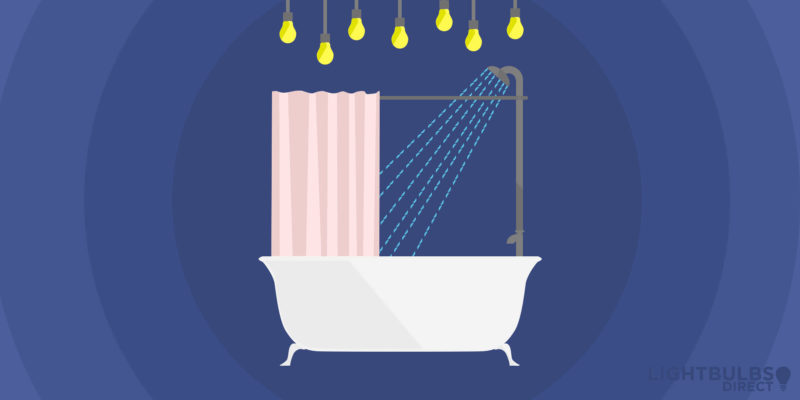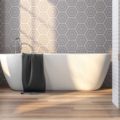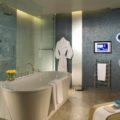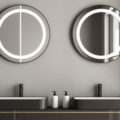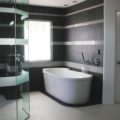What are IP ratings? Why is it relevant to lighting your bathroom?
The most important element to consider, though, is often the one that gets overlooked: safety.
Mixing electrical components with water is never a good idea.
This is especially important in a wet and humid environment such as your bathroom. Getting the correct IP Ratings for the environment is essential.
So, how do you install lights in a room that by its very nature makes it hazardous to do so?
Look for the IP Ratings
An IP rating (or IP code) is a measure of how well a piece of equipment is protected from water and solid objects. It can be present on everything from smartphones to outdoor sockets but is especially pertinent for lighting.
An Ingress Protection rating consists of the letters ‘IP’ followed by two numbers.
The first number applies to the ingress of solid objects, foreign bodies or dust.
The second number represents the degree of protection for the ingress of water and fluids.
The two tables below outline what each number means and allows you to gauge how enclosures with a certain rating would perform under a specific set of conditions.
The first number in IP ratings denotes the protection against solid objects:
| IP Rating | Object Size Protected Against | Effective Against |
|---|---|---|
| 0 | Not Protected | No protection from the contact and ingress of objects |
| 1 | >50mm | Any large surface, such as the back of the hand, but no protection against deliberate contact |
| 2 | >12.5mm | Fingers or similarly sized objects |
| 3 | >2.5mm | Tools, thick wires etc |
| 4 | >1mm | Most wires, screws etc |
| 5 | Dust Protected | Ingress of dust is not entirely prevented, but it shall not enter in sufficient quantity to interfere with the operation of the equipment; complete protection against contact |
| 6 | Dust Tight | No ingress of dust; complete protection against contact |
The second number refers to an object’s protection from water ingress:
| IP Rating | Water Droplet Size Protected Against | Effective Against |
|---|---|---|
| 0 | Not Protected | – |
| 1 | Dripping Water | Dripping water shall have no harmful effect |
| 2 | Dripping Water When Tilted to 15° | Dripping water shall have no harmful effect when the enclosure is tilted at a 15° angle |
| 3 | Spraying Water | Water falling as a spray up to an angle of 60° from the vertical shall have no harmful effect |
| 4 | Splashing Water | Water splashing against the enclosure from any direction shall have no effect |
| 5 | Water Jets | Water projected by a nozzle (6.3mm) against the enclosure from any direction shall have no harmful effect |
| 6 | Powerful Water Jets | Water projected by powerful jets (12.5mm nozzle) against the enclosure from any direction shall have no harmful effect |
| 7 | Immersion up to 1m | Ingress of water in harmful quantity shall not be possible when the enclosure is immersed in water under defined conditions of pressure and time (up to 1m depth) |
| 8 | Immersion beyond 1m | The equipment is suitable for continuous immersion in water under conditions specified by the manufacturer. Normally, this means the equipment is hermetically sealed. However, in certain cases, this might mean that water can enter the enclosure, but only in such a manner that it produces no harmful effects |
So what does all this mean in terms of lighting your bathroom safely?
The 17th edition of the IET’s (Institute of Engineering and Technology) Wiring Regulations includes an amendment that designates certain IP Zones for bathroom-based light fixtures and at what proximity from a water source these fixtures should be placed.
The diagram below illustrates the relevant dimensions and proximity.
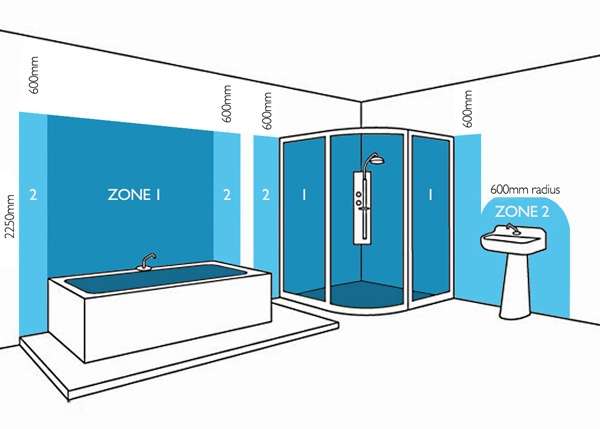
- Bathroom Zone 0 is the area either directly in the bathtub or shower basin. These are areas where any fitting would actually be submerged and therefore require an IP rating of at least IPX7. The 7 in this instance denotes the fitting’s ability to prevent the “ingress of water in harmful quantity […] when the enclosure is immersed in water under defined conditions of pressure and time (up to 1m of submersion)”. It is worth noting that in the context of IP Zones there is no requirement for the enclosure to resist solid objects; if water can’t breach its barriers then its resistance to solid objects is naturally spoken for and as such doesn’t need to be defined.
- Bathroom Zone 1 is the area either inside the shower cubicle or that directly above the bathtub (to a height of 2.25 metres). These are areas that will typically be subjected to multi-directional splashes and so would require a rating of at least IPX4. If this area is likely to be cleaned with focused washer jets then a rating of IPX5 is advised.
- Bathroom Zone 2 is the area that sits on either side of Zone 1, sitting at a distance of 0.6 metres away from the bath and/or shower and at a height of 2.25 metres if directly above. These areas require IP ratings of IPX4. Though again, if pressurised water jets are to be used to clean this area then a rating of IPX5 is preferable.
Anything outside these areas does not require a fitting with a specific IP rating. However, it is advised that any enclosure used inside a bathroom should have a rating at least comparable to those above. This is because the presence of steam in generally humid environments can cause light fittings to fail, even when the actual risk of danger is negated.
View our range of bathroom lights or read more on LED downlights.
